|
|
ALTERNATE Antenna Coax Cables:
We have LMR240 very-low-loss coax available in 5m 6m 7m 10m 12m 15m and 20m lengths.
And we can supply LMR400 Super-low-loss coax made to length, please contact us BEFORE purchasing.
|
|
|
ALTERNATE Patch Leads:
We have patch leads to suit a range of Mobile Phones and Modems.
Please contact us BEFORE purchasing.
TS5 for MF91, MS147, CRC9, TS9, N-type and RP-SMA Modem Adapter/Patch Leads.
Adjustments to your order may incur additional costs, so please contact us prior to purchasing.
|
|
LMR series Antenna Coax
50Ω Low Loss - Double Shielded
Suited to Mobile, Vehicle and Fixed-Wireless installations such as Cars, Trucks, Motor-homes, Office buildings and Homes.
When ordered with our antenna kits, we ensure that the whole thing fits together and will include gender-bender where required.
Double shielded by one layer of Aluminium foil and one close-knit copper braid make for a low-loss coax. Its low signal attenuation figures make it well suited for use at Cell Phone frequencies. Other equivalent prefixes include CLF, KMR.
| |
|
|
RG58 |
LMR195 |
LMR240 |
LMR400 |
| Impedance: |
50Ω |
| Outer Diameter: |
4.95mm |
4.95mm
|
6.2mm
|
10.3mm |
| Inner Conductor: |
0.94mm
Copper |
0.94mm
Solid copper |
1.2mm
Copper over steel
|
0.94mm
Copper over aluminium
|
| Outer Sheild: |
70% Braid |
Bonded Aluminum Foil + 95% Tinned Copper Braid
|
| Dielectric: |
Solid PE |
Physical Foam Polyethylene
|
| Pros: |
cheap |
Low loss
Flexible |
Very low loss |
Super low loss |
| Cons: |
Hi loss
over long runs |
|
more rigid |
more rigid |
| Application: |
Mobile and Vehicle installations of less than 1m |
Mobile, Vehicle and Fixed wireless installations of 5-10m in moderate signal areas.
|
Fixed wireless installations <10m in moderate,
<5m in low signal areas. |
Fixed wireless installations <20m in moderate,
<10m in low signal areas. |
| |
|
|
|
|
| Signal Loss over 10m cable length (dB) |
| |
RG58 |
LMR195 |
LMR240 |
LMR400 |
| 850 MHz |
5.7 |
3.5 |
2.4 |
1.25 |
| 900 MHz |
5.8 |
3.65 |
2.48 |
1.28 |
| 1800 MHz |
no rated
for use
above 1000MHz |
5.24 |
3.6 |
1.93 |
| 2100 MHz |
5.5 |
3.8 |
2.0 |
| 2400 (WiFi) |
6.1 |
4.1 |
2.2 |
|
|
| |
|
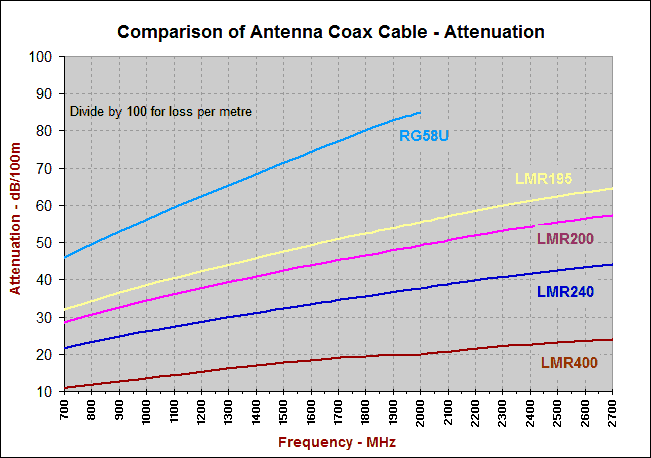 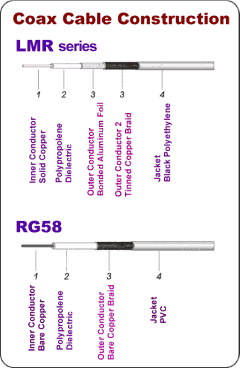
|
|
|
|
|
|
LMR series
The LMR series coax cables are made with low loss Dielectrics (2) and Double shielded with Aluminium Foil (3) and 95% Tinned Copper Braid (3). The outer plastic cover can vary from soft plastic to hard uv rated PVC.
This makes for a very low loss cable suitable for long runs at the microwave frequencies used for 3G and 4G mobile phone services. All our antenna kits are supplied with LMR195,240 or LM400 as required. Many of our Patch Leads use LMR100A rather than the more lossy RG174 commonly available.
RG58
In general, RG series coax such as the common 50 ohm RG85U uses a more lossy Dielectric (2) and only 70% single layer outer shield (3). These cables are not rated for use above 1GHz and are not suitable for use with cell phone antenna systems at cable lengths over about 1-2m. RG174 is used for most Patch Leads for its flexibility. RG174 is more lossy than the LMR100 coax we fit to our Patch Leads. This can make a difference at higher cell phone frequencies.
|
RG6 and RG11 (75ohm)
TV and Satellite antenna systems use 75ohm RG6 and the less common lower loss RG11 coax cables. These are high quality coax cables but unfortunately not suitable for mobile phone and wireless internet antenna systems.
- The N, SMA and FME type connectors used for 3G/4G antennas are not compatible with the RG6/11 coax.
- RG6/11 coax is 75ohm which will cause a high SWR if attached to the 50ohm Modem and 3g/4G antenna system.
- This impedance mismatch can cause damage to modems due to the high level of reflected power at the 50ohm/75ohm junctions.
- Poor performance, depending on the real-world antenna impedance may result.
Thus we do not guarantee the performance of our antenna systems when used with the incorrect coax cable.
|
|
| |
There are many different modems with different antenna connections.
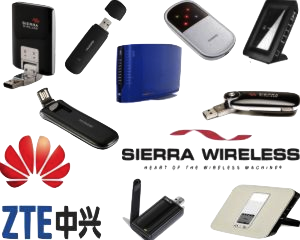
|
My modem does not have an External Antenna Socket ..
Can I use these Antenna Kits ?
We only support modems that have a physical external antenna socket. "Inductive Couplers" are available, but with less than ideal results. Always use a Modem that has an External Antenna Port.
My modem has an External Antenna Socket ..
Will your Antenna Kits fit my modem ?
There are many different types of antenna connectors. If you don't see your modem /router listed above, please ask us and we'll do our very best to help you.
Will these antennas suit 4G and 3G ?
Telstra, Vodafone and Optus are using 4G services on the 1800MHz band. In 2015, 4G and 4Gx will be available on the 700MHz band.
We also have 20dBi Parabolic Dish antennas for 1800MHz 4G.
The higher gain antennas suit one band only. Please check the table above to ensure the antenna listed above is correct for your needs.
|
What frequency antenna do I need 850, 900, 1800, 2100 ?
A very high gain yagi antenna (16dBi) will cover only one 3G or 4G band, such as 850, 900 or 1800MHz.
The lower the antennas gain, the more bands it can cover. Thus our mid-gain antennas are suitable for both Telstra/Vodafone and Optus on both bands.
|
|

Where are the
Mobile Internet Towers
in my area ?
Follow our guide Find Cell Towers Guide to determine the best path to the best tower from your location.
|
Metropolitan Areas
- All carriers use 2100MHz for 3G/nextG.
- Telstra have 850MHz NextG in selected metro areas.
- Optus have 900MHz 3G in selected metro areas.
- Vodafone have 850MHz and/or 900MHz 3G in metro areas.
- Most 4G LTE services use 1800MHz. Not all towers are MiMo
Rural Areas
- Telstra use 850MHz for NextG (3G).
- Optus use 900MHz for 3G.
- Vodafone use 850MHz and/or 900MHz.
- 4G 700MHz is to be rolled out early 2015 by Telstra, Optus
and Vodafone. Being a lower frequency, this service is aimed at
providing more regional customers with 4G access since
Line-of-Sight to the tower is not needed as is the case for
4G 1800Mhz.
Telstra will roll out 4GX early 2015. "4GX" is Telstra's brand name for "4G CA" or 4G Carrier Aggregation. 4G CA uses both 700+1800MHz to double the speed over 4G single band.
Thus 4G CA can be as fast as 4x that of standard 4G SiSo.
We also have all-band antennas that available that cover all 3G and 4G bands worldwide.
Rural cell towers may utilize both the 850(900) and the 2100 3G bands simultaneously to assist them with town & country coverage, however a modem will only connect to one band at a time.
Do I need "Line of Site" to a cell tower ?
Short Answer:
3G 850 and 900MHz : No.
3G 2100MHz and 4G 1800MHz and 4GX : Yes
4G 700MHz : No
Long answer:
In rural areas using 700/850/900MHz, signal may be refracted around and reflected off of hills that would block the higher frequency signals of 1800/2100/2300/2600MHz. This is why the carriers use the lower frequency in country areas. However the signal you will receive without direct line of site to the cell tower will be greatly reduced. At above 1800MHz, direct line of site is a must. But this does not mean you need to be able to see the tower. The signal is absorbed by buildings, trees and other vegetation, but its high frequency waves cannot go through or around hills and mountains.
|
There are two main types of antenna:
Directional and Omnidirectional
|
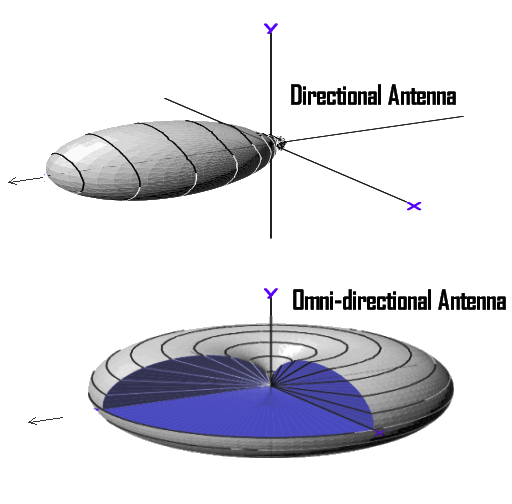
Omnidirectional antennas achieve higher gain by flattening out the "donut".
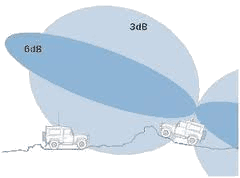
If your constantly on the move you need an antenna that can connect to cell towers in any direction.
Vehicle speed, terrain changes and boat angle/movement effect the angle of the antenna, causing reliability issues with higher gain antennas.
|
| |
Fixed Wireless Installations: Homes, Office and Semi-Mobile
Directional - Yagi, Panel and LPDA antennas |
| |
Advantages
- Higher gain, providing more "bars" of signal.
- Less interference from the side and from behind the antenna.
- Better Signal-to-Noise Ratio providing better Signal Quality for the
same Signal Strength of omnidirectional antennas.
- Possible to connect to more distant, lower signal cell towers that may
have less traffic load than your closest tower.
|
| |
Disadvantages
- Must be aimed at the cell tower.
- Not suitable for Mobile Installations. |
| |
Recommended Antenna Gain
Marginal Signal Areas:
|
16dBi Single Band Yagi.
|
| Medium/High Signal Areas: |
9-14dBi Multi-band or Dual Band Yagi |
|
|
| |
|
| |
Mobile Installations: Mobile Homes, Caravans and Motor Vehicles
Omni-directional - (Broomstick and Whip) antennas
|
| |
Advantages
- No need to aim at the cell tower.
- Ideal for Mobile Installations. |
| |
Disadvantages
- Lower gain, providing less signal.
- Wanted and unwanted signals collected equally from all directions.
- possible to connect to more distant, lower signal cell towers that may
have less traffic load than your closest tower.
|
| |
Recommended Antenna Gain
| Mobile Homes and Caravans: |
7-9dBi All-Band Omnidirectional. |
Road Vehicle, Metro Areas:
|
3-7dBi All-Band Omnidirectional. |
Road Vehicle, Country Areas:
|
7-9dBi All-Band Omnidirectional. |
| Off Road Vehicle, 4WD: |
3-7dBi All-Band Omnidirectional. |
Marine, Boats and Yachts:
|
3-5dBi Single/Dual Band Omnidirectional. |
|
|
|
The truth about antenna specifications.
|
I see other stores sell shorter, higher gain antennas ..
Why are your antennas lower in gain?
We don't exaggerate the performance of our antennas.
There are sellers listing antennas that they claim are 16dBi and even 21dBi gain, yet these antennas are shorter!
For each 3dBi antenna gain increase, the number of Elements (thus the total length) needs to double.
For example... a true 3G 850MHz 16dBi antenna will be >1500mm in length, so a 19dBi would be more than 3m long. Thats a simple example, its actually more complicated than that, but Ill spare the details.
It is mathematically impossible for to achieve the gain claimed from such small antennas!
BUYER BEWARE of these resellers and manufacturers that are advertising specifications that are just not possible to achieve. We are not going to name-and-shame here because many sellers do not have the engineering qualifications nor antenna experience to realize that their manufacturer/supplier has simply exaggerated the specifications, and the seller just repeats the misleading specs when advertizing.
To assist you in making the right choice we've provided some comparison examples below:
|
|

|
Claimed Performance:
18dBi, 22dBi even 24dBi on 850/900/1800/2100MHz L=1m
Truth:
This antenna is 3/4 of the size required for a 16dBi 850MHz single band yagi and actually shorter than our 13dBi yagi. The real performance is about 13/15/9/9dBi. Its model number is Yagi-02.
The very fact that it may be advertised as 18dBi, 21dBi and even 24dBi is enough to raise alarm bells!
|
|

|
Claimed Performance:
14dBi 800-1000MHz and 16dBi 1700-2200MHz L=1.1m
Truth:
This antenna is of log-periodic design. It does indeed cover the bands the seller states. However the absolute, "no-magic-wand" maximum gain of this type of antenna over such a wide band is 12dBi. Its a mathematical limitation. Weve done a signal strength comparison with our 16dBi 3G and 4G yagi's and our 9dBi MiMo panel antenna and have found its real gain to be about 11/12dBi as expected.
Also, the seller says it has 54 elements, when in truth, it has only 25!
|
|

|
Claimed Performance:
12dBi 700-2700MHz L=~445mm
Truth:
This is one of our antennas, it has a gain specification of 10/11dBi .
There are sellers on eBay and elsewhere that claim that their version is 12dBi. So how can one LPDA antenna of exactly the same design and physical dimensions as another perform better ? Well... it cant. These are not 12dBi as they would need to be as long as the antenna above. Its just a matter of how much the seller is prepared to stretch the truth.
|
| |
|
| |
|
|
I have NO SIGNAL in my area ..
Will this antenna give me 3G reception ?
If others around your location are able to get some signal then, when optimally installed, this antenna will help. One way to find out is to get a High-Gain Yagi Antenna and mount it in the best possible location. Although we don't guarantee this, many of our customers have reported being able to access high speed 3G internet in locations that previously showed no signal bars at all.
I have WEAK SIGNAL in my area ..
Will this antenna give me 3G/4G reception ?
If you have low and/or unreliable 3G signal using your USB modem inside or outside your building we 100% Guarantee that, when correctly installed, this antenna will greatly improve your 3G/4G signal quality.
I have GOOD SIGNAL but my connection is slow and drops out ..
Will this antenna fix this ?
Generally yes, if your problem is due to poor Signal Quality rather than Hardware or Service Provider issues.. these Directional Antennas will improve your 3G Internet connectivity by:
- Reducing interference from areas behind and to the side of the antenna.
- Reducing reflected and refracted signal coming from Buildings and Vehicles.
|
How high should it be off the ground?
|
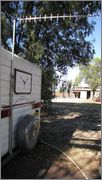
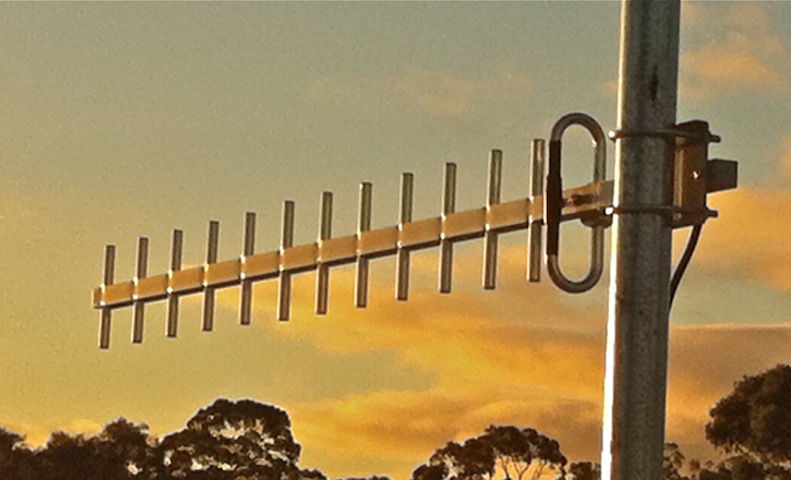
|
Can I mount the 3G/4G antenna on my existing TV mast?
Yes. The same rules for securely mounting any antenna apply.
For best results:
1. Mount the 3G antenna >300mm from the existing TV antenna.
2. Ensure the pole is fixed securely to the building reducing
wind effects. Additional diagonal supports may be needed.
3. Point the antenna at the Phone Tower.
The phone tower is rarely in the same direction as the TV tower.
Can I mount the 3G antenna in my roof space?
Any vertical or horizontal pipe, roof edge, wall, balcony railing etc can be used. Also, inside-attic hidden install may be acceptable as long as there is no metal in the roof that signal has to penetrate. RF signals at 824-960MHz) may be reduced by wood and concrete roof structures so avoid mounting inside a building if signal strength is marginal or if mounting a 2100MHz or 1800MHz antenna.
I have a 20m tower, should I run a 20m antenna cable or should I mount the antenna lower at 10m ?
At these frequencies, coax cable loss is a big factor. Consider that if there is only an extra 1dB gain increase at 20m over the signal at 10m then you could actually loose 3dB of antenna gain by mounting higher. So try it out at 10m. If you get good signal then don't bother raising it. Remember that Signal Quality is more important than Signal strength. On the other hand if you are able to achieve line-of-sight to the cell tower by increasing the antenna height the net gain can be quite substantial.
|
Directional antennas need to be aimed at the cell tower
|
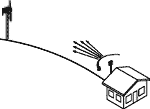 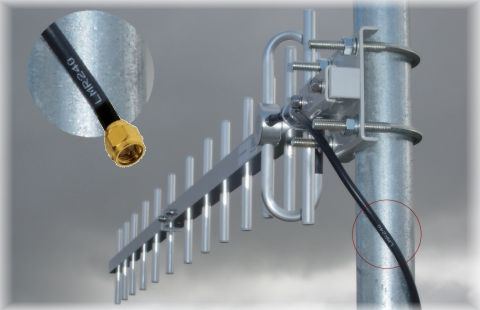
|
Installation
If you haven't already done so, find out which towers are nearest to your location. You can also determine the frequency your carrier (Telstra, Optus etc) is transmitting from each tower.
Direct the front of the antenna (usually the thin bit) at the mobile phone tower. The guide linked to above will identify landmarks in he path to the tower from your location and the Azimuth angle of the tower with respect to your position. If using a compass, be aware that metal objects such as a tin roof will upset the compass reading.
Alternatively, satisfactory results may be achieved by rotating your Yagi until best signal is found then centering on the estimated location.
- Slowly rotate the antenna and stop every 10 degrees.
- Wait 30sec's for the Modem's signal meter to refresh.
Record signal levels.
- Note the peak and decline positions.
- Determine the centre position between the two decline positions.
- Tighten the mounting bolts.
Stand at least a metre away from and to the back or sides of the antenna. Never stand in front of the antenna. Your body can greatly alter signal patterns.
|
|
Yagi Radiation Pattern
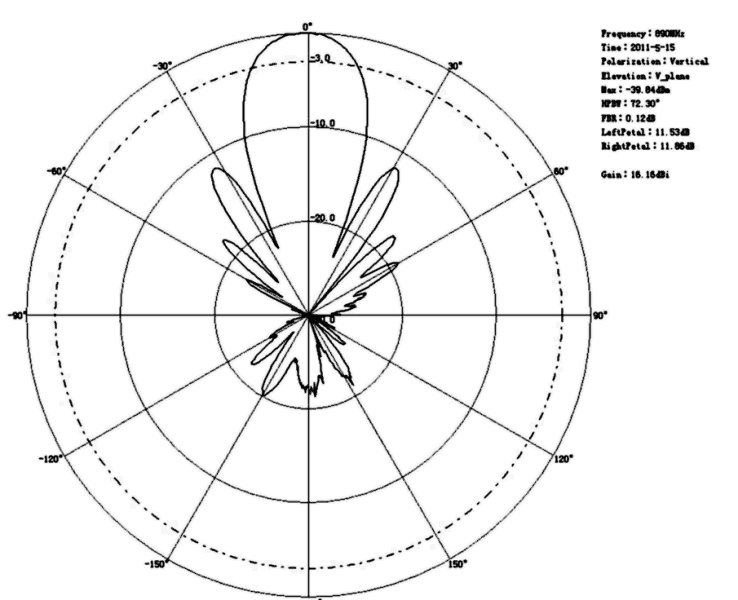
|
Directional antennas such as Log-Periodic and Yagi antennas direct most of their signal in just one direction instead of dispersing all around a 360 degree circle.
Single element whips and rods on cars, boats etc are omnidirectional, radiating in all directions when viewing from above, looking down on the antenna. The longer the the antenna, the more "elements" it has, the higher the gain.
To double the antenna gain (increase it by 3dB) its length and number of elements must double. There are both mathematical and physical limitations to the maximum gain that can be achieved. The 3G and 4G bands are very wide, which limits the maximum gain to begotten from a 'single band' Yagi covering the 850MHz band (824-890) is 16dBi. Likewise, a Yagi antenna designed to cover both the 850 and 900MHz bands (824-960) will be limited to 14dBi. The maximum gain achievable in practice with a Log-Periodic type antenna, regardless of its bandwidth is about 11dBi.
|
|
 Vertical-Polarized antenna for Vertical-Polarized antenna for
3G or 4G LTE single antenna installs
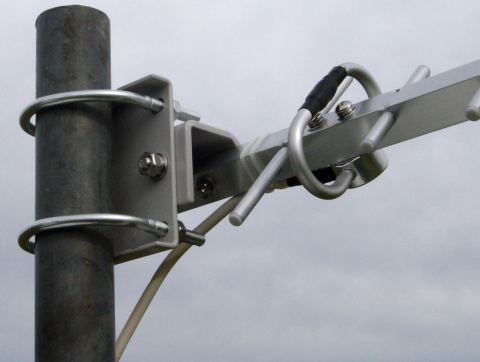
Slant-Polarized antenna for DC-HSPA+ or 4G LTE MIMO
|
Yagi antenna basics.
Boom: The long horizontal bar that points at the cell tower.
Elements: The small thin rods supported by the boom.
For Single 3G/4G Antenna Installations, mount the antenna with elements vertically positioned, as seen in the pictures. The front of the antenna has the shorter elements and the rear has the longer ones.
Reflector: Is at the rear the boom, This "reflects" the signal forward.
Driven Element: The "driven" element radiates the power from the modem and converts radio waves from the cell tower into electrical voltage.
Directors: Usually 1 to 15 or more elements specifically tuned to direct signal forward along the boom from/to the driven element.
The signal output is off the front end of the boom.
What is Polarization ?
Radio signals travel oriented vertically, horizontally, circularly or combination's of these. Cellular signals are Vertical or Slant polarized. Your cellular mobile antenna on the car is vertically polarized, for example.
Single Yagi's for cellular must be installed with its elements vertically polarized too. A Dual or MIMO Antenna system for 4G LTE or DC-HSPA 3G connection needs to be Slant-Polarised. See our Dual Yagi Listings.
When to use VERTICAL Polarization.
- 3G and NextG
- Single Antenna systems for 4G LTE.
When to use SLANT Polarization.
- Dual Antenna systems for 4G LTE.
In low/unstable signal areas, where the signal is not coming in a direct line from the tower, 3G can benefit from the use of X-pol antenna system with modems that support Antenna Diversity mode.
|
Does more signal always mean more speed ?
Signal Strength vs Signal Quality
- Signal Strength: how many "bars" or "dBm" are showing on your device.
- Signal Quality: how "clean" the signal is.
Improving signal strength to your device is normally the best way to get a better connection to your 3G or 4G service.
Generally speeking, Improved Signal Strength = Increased Data Transfer Speed.
In reality, things are a little more complicated than that. Installing an antenna system can definitely solve the signal quality problem, after that its up to a whole bunch of other factors, mostly on the telco side....
Think of these antenna kits as being a device that removes one of the "weak links in the chain".
Installing a high-gain directional antenna improves the signal strength and the signal quality.
This increase in the signal strength and signal-to-noise ratio is achieved by collecting more of the intended signal from the tower and less interference from neighboring cell towers, other transmitters and background RF interference.
Connection Quality
- Speed of data transfer: is it fast, smooth and consistant?
- Stability: does the modem stay connected, without dropping out or downloads stalling?
Although there tends to be relationship between signal strength and signal quality, signal quality and connection quality are more closely related.
With good Signal Quality:
- Modem will spend less time performing error checking and error correction tasks.
- Modem will not repeat downloads of data packets when it cannot correct errors.
- Thus the modem will have more time available to download/upload data.
- During Peak-Load times your Modem/Phone will be allowed to stay connected to the cell tower while customers with lower quality connections will be dropped or speed limited. The cell tower decides this automatically based on a complex algorithm mostly influenced by the quality of the connection.
- The transmit power of your modem will be lower, using less power and running cooler.
RE: Other Factors affecting Connection Speed
There are other factors that we have little control over.
These are to do with the quality of the service provided by your Mobile Broadband/Mobile Phone company, including but not limited to:
- Backhaul: How fast can the data get to/from the Cell Tower by the Telco's own microwave, fibre links..
- How many licenses (data pathways) does the Cell Tower have installed.
- How many customers (aka subscribers) are tying to use the service in peak and off-Peak time periods.
- Optus and Telstra resellers may not be allocated a teir-1 priority service. Thus customers of reseller may not get the same speed and connection quality as a customer of the originating telco.
- The type of Plan you have.
- The specifications and quality of the modem/phone you have.
- Your location to the tower and how many other connection sources are available for your modem to connect to.
- Using a 4G MIMO antenna with a 4G MIMO modem (2 antenna ports) allows your modem to operate in MIMO mode if the Cell tower is MIMO enabled.
Not all towers are 4G MIMO so using a MIMO antenna does not always guaranty higher speeds. You will get higher DL speeds only if the Cell Tower is capable of doing so.
Conclusion
Q: So.. how does signal strength translate to download an upload speeds?
A: As a general rule, notwithstanding the other factors involved:
Improved Signal Strength => Improved Signal Quality => Improves Connection Quality => Increased Data Transfer Speed
Exceptions to the Rule
Q1: What situations would show no or only little improvement after installing a hi-gain antenna.?
A: Not many, but there are odd occasions where things dont work out. Notwithstanding the telco side issues listed above.
- Sometimes, when the signal path from your location to the tower is over water. The signal reflected off the waters surface can interfere with the direct signal causing much lower signal strength and unstable connection.
- When you just dont have enough signal no matter what antenna you use.
- Where you dont have a strong signal from the direction of the tower, the signal your modem is seeing is an (possibly ever-changing) combination of reflected, refracted, diffracted and direct signal from one or a number of cell towers.
- Where your signal quality is already good, improving the signal strength may make no difference to download speed.
Q2: I have good signal strength but my modem still drops out and the data transfer speed is too slow, what gives?
A: Normally this problem is due to Poor Signal Quality for the reasons outlined above. Our customers report this issue constantly and most often in the following situation:
- Modem is being used inside a building (of course it is) without an external antenna.
- A number of towers are available for the modem to connect to at your location.
For these reasons the signal your modem is seeing is an (possibly ever-changing) combination of reflected, refracted, diffracted and direct signal from one or a number of cell towers. The modem may be constantly dis-connecting and reconnecting to different towers or even different services and/or bands on the same tower, posibly not ever connecting to any service properly. The strong signal is also contains a lot of interfere. Thus the Signal Qualiy is poor
Here the aim of installing a high-gain directional antenna is to fix the signal quality issue rather than signal strength.
Factors that Determine Antenna Range.
With 3G and 4G antenna systems, there are many factors that determine the distance that your location can be from the tower to be able to get enough signal to achieve a good connection:
Line of Sight (LOS)
- Obstructed path from Your Antenna Position to the antennas on the Cell Tower.
These include hills, mountains, forest, scrub, buildings etc. This is called Line-of-sight .
- Any obstructions will cause signal degradation and the higher frequencies are most effected.
- The lower frequency 3G bands of 850 and 900 can refract (bend) around obstacles to some extent,
often enough to get quality signal to your location.
- The higher frequency 3G bands of 2100 and 4G 1800 generally require direct line-of-sight.
Exceptions to this are if you are very close to the cell tower or the signal is reflected of an obstacle.
- The bigger the obstacles, and more obstacles there are in the path, the less signal you are likely to see at your location.
- Bodies of water also cause problems that may reduce the signal strength.
- Atmospheric conditions such as "solar radiation" when the sun is in the direct path of the antenna alignment to the tower.
This electromagnetic "noise" can cause connection drop-outs.
- The curvature of the earth creates an obstacle to the signal path over distances greater than about 26-30km.
Most effect when over, and least influence when the cell tower and your location are at high altitude with a valley in-between.
In practice the maximum distance could be around 75km for 3G 850MHz and about 40-50km for 4G 1800MHz.
To properly assess the signal you can expect at your location, please follow our Find Cell Towers Guide.
Cell Tower Maximum Range.
The Mobile Phone Cell Towers themselves have a maximum range built into the software configured by the service provider.
This is the maximum time it takes for the handset to respond to a request from the cell tower, beyond which the tower will reject a connection.
The intention of this is to restrict the tower from being oversubscribed.
Rural towers may be set to a "Service Window" of 135km to 160km.
Metro towers may be set with a service area as low as 30km.
Handset Power
Whilst the cell tower power may be 20W or even over 100W, your Phone or MBB will only transmit at 3W or 34dBm maximum.
An 11dBi antenna, being a lower gain having to cover many bands, will not have the range as a 16dBi Yagi antenna that targets a single band.
Other factors
Getting a strong signal and solid connection to the cell tower is only half the battle.
Australian 3G Wireless Broadband & Mobile Phone Frequencies
|
The information provided is current at time of writing and subject to change without notice.
|
| |
| Carrier/Service |
Band |
Mode |
Bandwidth 4 |
Antenna Type
|
Telstra/Bigpond nextG
|
850MHz
Band 5 |
3G UMTS/HSPA |
DL: 875-890 MHz
UL: 830-845 MHz
|
Vertical Pol
Omnidirectional
|
Telstra/Bigpond nextG
(also shown as 4G in some areas)6 |
DC-HSPA+ |
DL: 875-890 MHz
UL: 830-845 MHz |
Dual Carrier
Slant Pol |
Vodafone 3G
|
UMTS/HSPA |
824~894 MHz |
Slant Pol |
| Vodafone 3G+ |
DC-HSPA+
|
824~894 MHz |
Dual Carrier
Slant Pol |
| Optus, Virgin (900) 3G |
900MHz
Band 8
|
UMTS/HSPA
|
DL: 943-952 MHz
UL: 898-907 MHz |
Vertical or Slant Pol
Omnidirectional
|
| Vodafone (900) 3G |
UMTS/HSPA |
DL: 951-960 MHz
UL: 906-915 MHz |
Telstra voice/sms
|
1900MHz
|
UMTS
|
1850~1990 MHz |
Vertical Pol |
Vodafone, Optus, Telstra
GSM/3G - voice/sms/data
|
2100MHz
Band 1
|
UMTS/HSPA
|
DL: 2110-2170 MHz
UL: 1920-1980 MHz |
Slant Pol |
|
Australian 4G Wireless Broadband & Mobile Phone Frequencies
|
The information provided is current at time of writing and subject to change without notice.
|
| |
| Carrier/Service |
Band |
Mode |
Bandwidth 4 |
Antenna Type
|
OPTUS 4G LTE
|
700MHz
Band 28
|
4G FD-LTE 700
from 31 DEC 14
|
UL 703-713MHz
DL 758-768MHz
|
MIMO
X-Polarized 5 |
Telstra 4G LTE
|
UL 713-733MHz
DL 768-788MHz |
| Telstra (700) 4G |
700MHz
Band 28 |
4G FD-LTE |
703~803MHz |
|
| Telstra - 4G LTE |
1800MHz
Band 3
|
4G LTE FDD
|
DL: 1805-1820 MHz
UL: 1710-1725 MHz |
MIMO
X-Pol |
Optus (and Virgin)- 4G LTE
|
DL: 1840-1850 MHz
UL: 1745-1755 MHz |
| Vodafone - 4G LTE |
TBA |
1 Telstra - 4GX
4G Carrier Aggregation
|
700+1800MHz
B28 + B3
|
4G LTE
|
703~803MHz
+ 1710~1880MHz |
2x MIMO X-Pol |
Optus - 4G LTE TDD 2300
|
2300MHz
Band 40 |
4G TD-LTE
|
2302~2400 MHz
shared between UL/DL
|
MIMO - X-Pol |
|
Optus - 4G LTE 2500
|
2500MHz
Band 7
available: TBA
|
4G FD-LTE
|
UL 2550-2570MHz
DL 2670-2690MHz |
MIMO - X-Pol |
Telstra - 4G LTE 2500
|
4G FD-LTE |
UL 2510-2550MHz
DL 2630-2670MHz |
MIMO - X-Pol |
TPG - 4G LTE 2500
|
4G FD-LTE |
UL 2500-2510MHz
DL 2620-2630MHz |
TBA |
|
|
1 Telstra has branded its 4G CA (carrier aggregation) service as "4GX"
|
New 4G LTE 700MHz and 2500MHz Mobile Broadband Spectrum
|
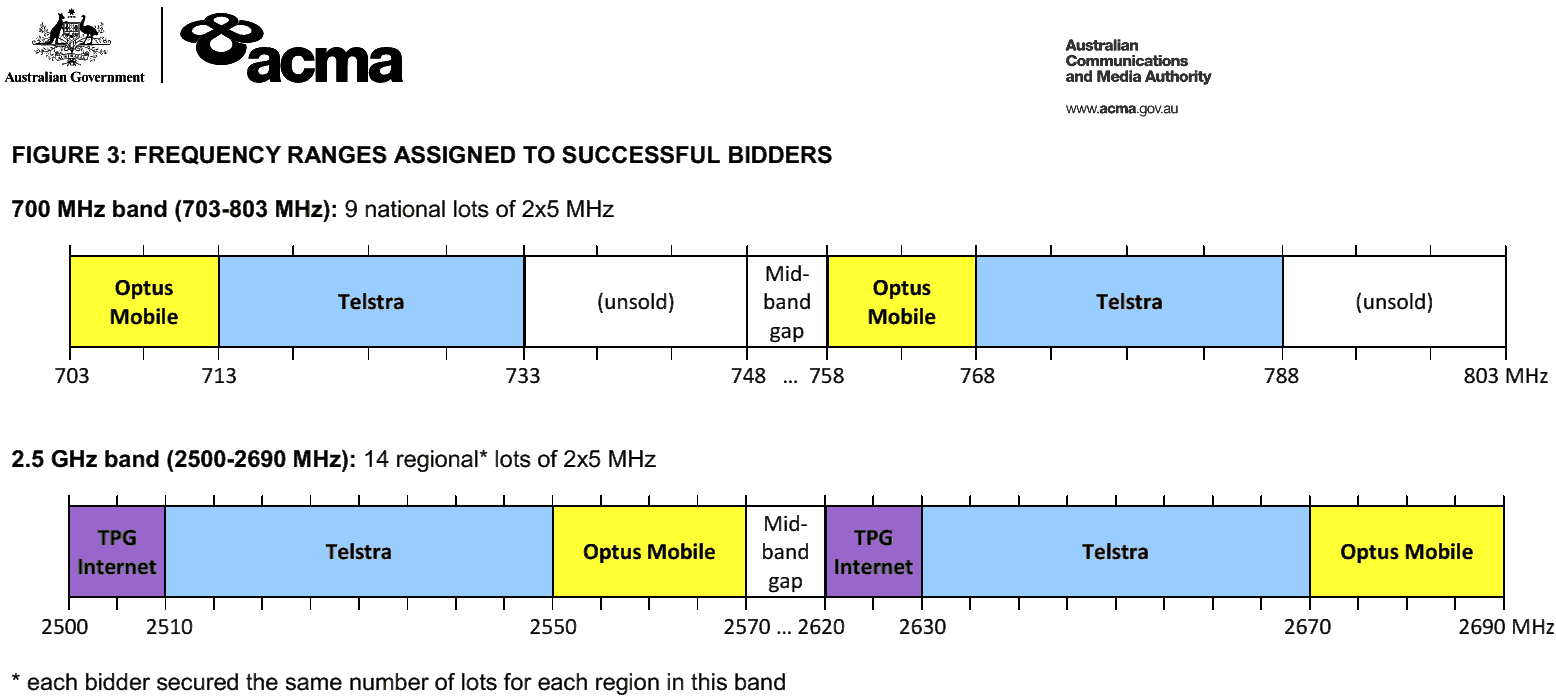 |
| |
| The information provided is current at time of writing and subject to change without notice. |
|
|
We ship worldwide with a a few exceptions.
Australian orders are shipped by Australia Post eParcel.
If you need the item in a hurray please select Express postage.
Delivery Times:
Where applicable *Unless stated otherwise in the Product Description:
eParcel Parcel Post: - 2-7 business days if ordered before 2pm ACT (SA time).
Express eParcel: - 1-4 business days if ordered before 2pm ACT. (Next Day for AusPost Express Guaranteed zones.)
Australia Post does not deliver on weekends. Orders placed over the weekend or on public holidays will be dispatched on the next business day with normal delivery times applicable.
We provide full support and warranty for all products. Australian Law provides consumers with standard guide-lines for Return Merchandise, please refer to the OBCA for more information.
REFUNDS: Were a refund partial or full is due:
A: If you paid for your order via Paypal or credit card your refund will be via same.
B. If you paid by Cheque or Direct Bank Deposit refunds are transferred by direct transfer. You will need to supply account details to complete the refund. We do not send refunds via cheque.
DEAD ON ARRIVAL, FAULTY or WARRANTY RETURNS (12 month warranty):
We will replace and ship any faulty item within its warranty period free of charge. You must first lodge an RMA Request prior to shipping the item back to us. Once we receive the returned item, we will test it for faults as discussed. If the item is found to be not faulty, in perfect working order, we will return the item at the customers expense. In this case shipping costs will apply and must be paid prior to re-shipping.
INCORRECTLY ORDERED or YOU CHANGED YOUR MIND:
BEFORE SHIPPED:
If you have ordered the wrong item or decided that you no longer want the item we are willing to cancel this order prior to it being shipped, without any cost or negative impact.
AFTER YOUR ORDER IS SHIPPED: We may, after consultation, at our discretion, replace the item with a more appropriate item if available. The order balance will be adjusted to reflect the cost of difference of the alternate re-supplied item. Any additional payment required must be received before the re-supplied item(s) will be shipped. A re-stocking fee (see below) may be payable. Customer will be responsible for shipping costs of the re-supplied items. The original shipping cost will not be refunded. None of our products contain user-servicable parts.
We must receive all approved items in perfect un-marked and re-saleable condition.
- Original internal plastic bag & other packaging must be returned.
- Copy of the original invoice MUST be included.
- Items must NOT be MARKED, CHIPPED, SCRATCHED, DENTED, BENT or ALTERED from its delivered condition.
- All Mounting Brackets, U-Bolts, Nuts, Bolts, and other hardware MUST be returned (unless other arrangement has been agreed).
RE-STOCKING FEE Applies for items ordered by mistake and non-faulty returns. - $10 plus 10% of item total value of items returned.
INTERNATIONAL ORDERS: Returns for delivery addresses outside of Australia are not accepted. Please address your order carefully. If in doubt, please contact us before the item is shipped with an updated shipping address. Items returned as delivery failed, can be resent upon receipt of the additional postage cost and updated address details.Some countries, such as Saudi Arabia require additional information for customs clearance. In this event these may be some delay to the shipment.
More answers to common 3G and 4G questions
|
















